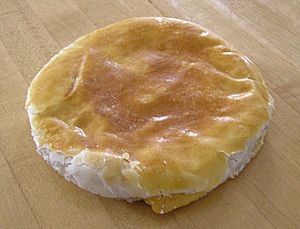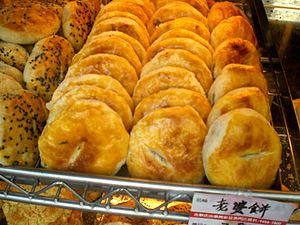Sweetheart cake facts for kids
 |
|
| Alternative names | Wife cake, Lo por beng, Lao po bing, 老婆餅,(Chinese name (simplified))老婆饼 |
|---|---|
| Type | Cake |
| Course | Snack, dessert |
| Place of origin | Guangdong, China |
| Region or state | Cantonese-speaking areas |
| Main ingredients | Winter melon, almond paste, sesame, five spice powder |
| Sweetheart cake | |||||||||||||||||
|---|---|---|---|---|---|---|---|---|---|---|---|---|---|---|---|---|---|
| Traditional Chinese | 老婆餅 | ||||||||||||||||
| Simplified Chinese | 老婆饼 | ||||||||||||||||
| Literal meaning | wife ("sweetheart") cake | ||||||||||||||||
|
|||||||||||||||||
A sweetheart cake (also called wife cake or marriage pie) is a yummy traditional Chinese pastry. It has a thin, flaky crust and a sweet filling. This filling is usually made from winter melon, almond paste, and sesame seeds. Sometimes, it also has a touch of five-spice powder for extra flavor.
The name "wife cake" comes from the Cantonese words lou po beng. While it means "wife," the words literally translate to "old lady cake." In Hong Kong, these cakes are a famous treat from the area called Yuen Long.
Contents
What's Inside a Sweetheart Cake?
Sweetheart cakes traditionally come from Guangdong province in China. The main part of the filling is made from candied winter melon. This sweet winter melon is mixed with white sesame seeds and a special flour called glutinous rice flour.
Sometimes, people also add coconut (either mashed or shredded) and almond paste. A little bit of vanilla might be included too. The sweet filling is wrapped in a special Cantonese-style pastry dough. To make the pastry super flaky and tasty, it's traditionally made with pork lard. Then, it's brushed with an egg wash to give it a shiny finish.
Today, because these cakes are popular around the world, butter is sometimes used instead of lard. However, using butter can change the taste a little bit. Sweetheart cakes are not as sweet as many Western pastries.
Sweetheart Cake vs. Husband Cake
You might find some versions of sweetheart cakes in Southeast Asia that use spices like Chinese five-spice powder. Even though this spice is from China, it's not usually in traditional sweetheart cakes.
It's easy to mix up sweetheart cakes with another pastry called the husband cake (老公饼 or Lao gong bing). The main difference is that husband cakes often have star anise in their filling, which gives them a different flavor.
Fun Stories About Sweetheart Cakes
There are many interesting stories about how the sweetheart cake first came to be. Here are a few popular legends:
The Poor Couple's Story
One story tells of a very poor couple who lived in ancient China. They loved each other very much. One day, a strange sickness spread through their village, and the husband's father became very ill. The couple spent all their money trying to help him get better.
To buy more medicine, the wife sadly sold herself as a slave. When the husband found out, he was heartbroken. He decided to create a special cake filled with sweetened winter melon and almond. He sold these cakes on the street, dedicating them to his wife, whom he missed terribly. His cakes became so popular that he earned enough money to buy his wife back!
There's another part to this story. After earning the money, the man went looking for his wife. He stopped at a teahouse for a cup of tea. Suddenly, he recognized the pastry they were serving – it was just like the one he made! This led to him finding his wife again at the teahouse.
The Chef's Wife Story
Another legend says that a chef who made dim sum (small Chinese dishes) had a wife who created a new pastry. She got the idea from a recipe her mother's family used, which included winter melon paste. Everyone thought her new pastry tasted even better than the dim sum the chef was selling! The chef was so proud that he told everyone his wife made it. That's why it was named "Wife Cake."
See also
 In Spanish: Pastelillo de esposa para niños
In Spanish: Pastelillo de esposa para niños


